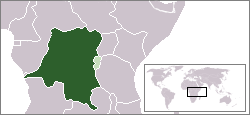Belgian Congo
| Belgian Congo | ||||||||||
|
||||||||||
| Colony of Belgium | ||||||||||
|
||||||||||
|
||||||||||
|
Motto Travail et Progrès "Work and Progress" |
||||||||||
|
Anthem Brabançonne "Brabantian" |
||||||||||
|
The Congo (dark green) depicted with Belgian Ruanda-Urundi (light green), 1935
|
||||||||||
| Capital | Léopoldville | |||||||||
| Languages | ||||||||||
| Religion | Christianity, Baluba religion, Bantu religion | |||||||||
| Political structure | Colony | |||||||||
| King | ||||||||||
| • | 1908–1909 | Leopold II | ||||||||
| • | 1909–1934 | Albert I | ||||||||
| • | 1934–1951 | Leopold III | ||||||||
| • | 1951–1960 | Baudouin I | ||||||||
| Governor-General | ||||||||||
| • | 1908–1910 | Théophile Wahis (first) | ||||||||
| • | 1958–1960 | Henri Cornelis (last) | ||||||||
| History | ||||||||||
| • | Annexed by Belgium | 15 November 1908 | ||||||||
| • | Independence declared | 30 June 1960 | ||||||||
| Area | ||||||||||
| • | 1960 | 2,344,858 km² (905,355 sq mi) | ||||||||
| Population | ||||||||||
| • | 1960 est. | 16,610,000 | ||||||||
| Density | 7.1 /km² (18.3 /sq mi) | |||||||||
| Currency | Belgian Congo franc | |||||||||
|
||||||||||
| Today part of |
|
|||||||||
The Belgian Congo (French: Congo Belge, Dutch: Belgisch-Congo) was a Belgian colony in Central Africa between 1908 and 1960 in what is now the Democratic Republic of the Congo (DRC).
Colonial rule in the Congo began in the late 19th century. King Leopold II of the Belgians persuaded the government to support colonial expansion around the then-largely unexplored Congo Basin. Their ambivalence resulted in Leopold's creating a colony on his own account. With support from a number of Western countries, Leopold achieved international recognition for a personal colony, the Congo Free State, in 1885. By the turn of the century, however, the violence used by Free State officials against indigenous Congolese and a ruthless system of economic exploitation led to intense diplomatic pressure on Belgium to take official control of the country, which it did by creating the Belgian Congo in 1908.
Belgian rule in the Congo was based on the "colonial trinity" (trinité coloniale) of state, missionary and private company interests. The privileging of Belgian commercial interests meant that large amounts of capital flowed into the Congo and that individual regions became specialised. On many occasions, the interests of the government and private enterprise became closely tied, and the state helped companies break strikes and remove other barriers raised by the indigenous population. The country was split into nesting, hierarchically organised administrative subdivisions, and run uniformly according to a set "native policy" (politique indigène). This was in contrast to the British and the French, who generally favoured the system of indirect rule whereby traditional leaders were retained in positions of authority under colonial oversight. The Congo had a high degree of racial segregation. The large numbers of white immigrants who moved to the Congo after the end of World War II came from across the social spectrum, but were always treated as superior to black people.
...
Wikipedia



